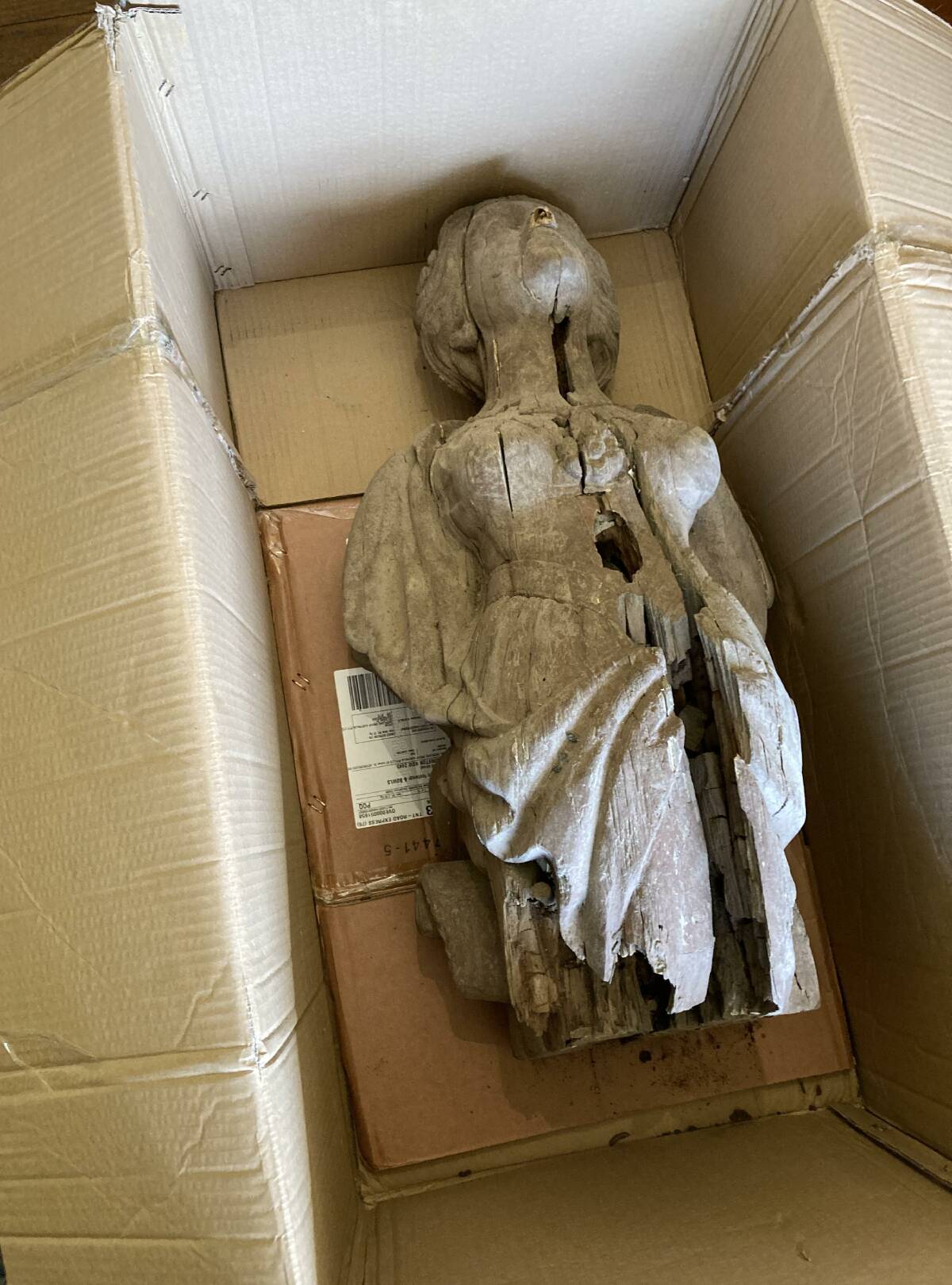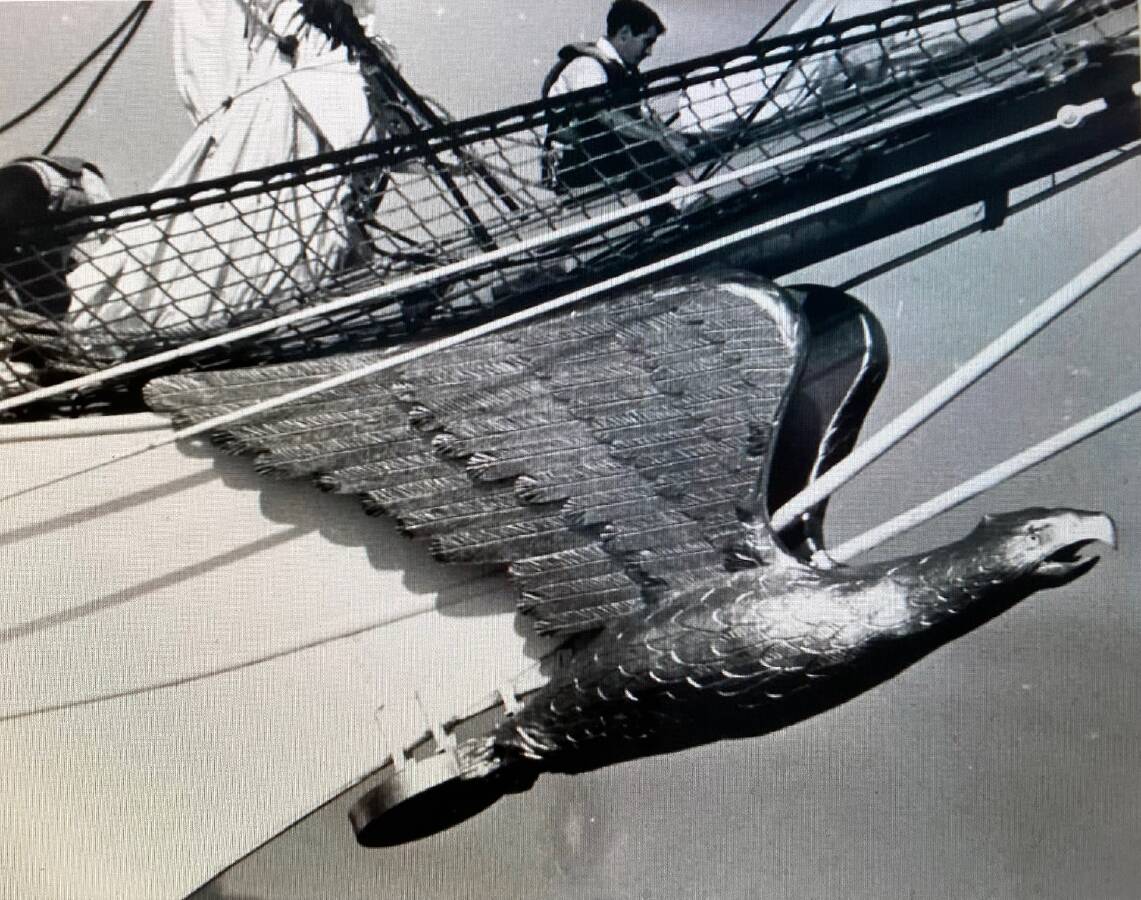
HER wooden eyes stare sightless into eternity. She is dressed in an old-fashioned style and decaying from old age. Not unusual considering this nameless object - a rare 19th century ship figure head - may be about 150 years old.
Now packed safely in a box, the weathered figurehead would have once graced the bow of a sailing ship, or steamer, to bring the vessel good fortune at sea.
For such sculptures were far more than pretty faces. Perhaps two thirds of them depicted women, often shown with at least one breast exposed. Initially many carvings, often of teak, showed naked ladies, as superstitious ship crews believed these sculptures had the power to calm storms at sea.

For centuries it was even considered unlucky for a ship not to carry a ship's figurehead, until modern ship design consigned the tradition to history's dustbin.
The most bizarre example of this superstition came after the wreck of iron barque Mandalay off Western Australia in 1911. Once ashore, the crew reportedly ritually beheaded the figure to "kill" the evil spirit of the ship.
Of the figureheads once spotted on hundreds of ships in the romantic, dying days of sail, perhaps only about 70 survive in Australia today. Those now fully restored in museums are highly prized. Many, however, ended up as firewood.
Today's featured mystery ship figurehead, about a metre long, was donated early last month to the Mid-North Coast Maritime Museum at Port Macquarie, which now hopes to preserve it.
The 19th century ship icon was given to the museum by maritime expert Phil Bowman, of Dunbogan, just south of Port Macquarie.
But even he is mystified where this ghost of the past may have originated.
"I found it inland, in a garden in Taree. That's the total sum of my knowledge," Bowman says.
"All I know is such finds are extremely rare. I went back again later to learn more from the previous owner but was unsuccessful.
"He knew of me, maybe only because I was associated with a move 15-20 years before to try and start a museum at Taree."
Bowman said he'd had the mystery figure head for a few years having originally planned to restore it himself.
"But I couldn't afford to repair it properly, so I thought it should go to a better home. It has dry rot," Bowman said.
"I think it's from a sailing vessel, more likely a foreign one, but which one? For example, in one north coast storm in the 1860s some seven rough and ready-style vessels, under 50ft (15m) long sank in one night alone," he said.
If the figurehead is indeed from an Australian vessel, it will be a long hunt. It's estimated that of the 253 NSW-built vessels with figure heads, fewer than a dozen sculptures survive today.
South Australia's Maritime Museum holds 17 precious figureheads, reportedly the largest single collection in the Southern Hemisphere, only sourced after a 20-year search.
Newcastle once had several of the rare figureheads, but then they vanished forever. Former Stockton maritime historian Terry Callen once told me that two visiting American women in probably the mid 1970s came to rummage through Stockton backyards and garages to buy figureheads, salvaged from Oyster Bank shipwrecks, to take home.
At first glance, Port Macquarie's ship relic resembles one now superbly restored and in Hobart Maritime Museum since 2013. It was donated by celebrity sailor Bern Cuthbertson of replica sloop Norfolk fame.
Bern said that in the 1960s he saw what appeared to be a wooden head sticking out of a large heap of firewood in a suburban Tassie backyard.
On discovering it was a figurehead, he knocked on the door asking if he could buy it. A woman covered in flour and angry from being disturbed making scones said: "Sell it? Take the bloody thing away - I don't want it."
Bern saved the object complete with .22 bullet holes and damaged features. His research identified the artefact as the figurehead from the old whaler and former warship, Waterwitch.
Launched in 1820 in Wales, it began life as the Royal Naval vessel HMS Falcon. The 10-gun brig then cruised off Africa suppressing the slave trade.
Later leaving service, she was renamed Waterwitch in 1842. From 1860, Hobart was the whaler's home port until finally being broken up in 1896.
Carved ship figureheads come in all shapes and sizes, from three-quarter length or reduced to elaborate busts. Those saved are now often brightly painted.
Vikings once used dragons to decorate the prows of their raiding ships, but there's evidence of Egyptian ship figureheads going back to 3000 BC. Britain's Royal Navy began restricting lavish ship carvings around 1700, but the practice was revived in the clipper ship era around 1858.
Besides women, other decorations include lions rampant, to ancient Hercules and Atlas, to Medusa, Greek warriors, English Kings, to richly carved and gilded sea serpents, mermaids and witches.
One of the biggest and most striking is the enormous carved gold eagle at the bow of the majestic US coast guard Eagle, which visited Newcastle Harbour on a goodwill visit in December 1987, in time to celebrate Australia's Bicentenary.
The Australian National Maritime Museum at Sydney's Darling Harbour has a large, colourful Lord Nelson carving among its prized collection of figureheads.
An ANMM spokesman said a maritime archaeologist suggested the Port Macquarie discovery may have come from one of Newcastle's old Oyster Bank wrecks.
Another expert said the bowsprit decoration was "quite rare", needing conservation sooner rather than later.
The ANMM spokesman said the apparent Tudor rose on the figure head's chest raised the suggestion that it might have come from a ship named "queen" something.
He said it seemed similar though to the figure on the barque Jenny Lyn, from Quebec, built 1847 then wrecked off Queensland in the 1850s. The opera singer was referred to as the "Swedish nightingale" and featured in the 2017 film on P.T. Barnum called The Great Showman.
The only trouble is there's at least 35 ships named after the Swedish singer.
Today at London's Greenwich, the Cutty Sark clipper museum has the largest collection of merchant navy figureheads in the world.
This grand surviving tea clipper (built 1869) was only meant to last 25 years, but is still around 153 years later. Her famous wooden bare-breasted sculpture of "Nannie" the witch had a new figurehead (probably her third) installed mid-last year. With arm outstretched and a billowing dress, the new ship symbol was carved from Swedish rosewood.
Newcastle Harbour's likely sole figurehead, however, was carved only 35 years ago by the late sculptor Matthew Harding back in 1987 for the replica steamship William the Fourth.







